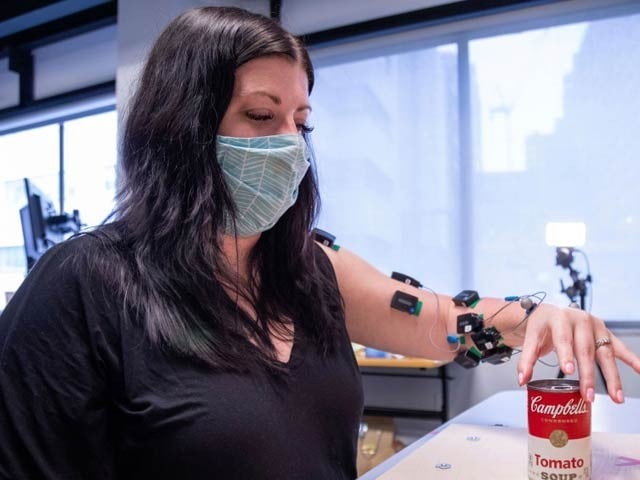
American experts have restored the movement of the hands of a woman who had lost the movement of her hands for the past ten years by applying electric current to the haram brain. Photo: Courtesy of The Guardian
Pittsburgh: Scientists from the University of Pittsburgh and Caring Mellon University have restored movement to the hands of a woman who lost movement in her hands and fingers after a stroke ten years ago.
Heather Randeaulac was just 22 years old when she suffered a stroke in 2012. After that, his right hand became somewhat weak, but his left arm was completely disabled. Now, electrodes have been placed on his neck and different parts of his arms and after ten years, he has regained movement in his hands and fingers.
After 10 years, Heather not only opened the lid of the bottle but also started eating with a knife and fork. Experts from Carnegie Mellon and the University of Pittsburgh have used a special electrical system to stimulate her spinal cord, which has returned Heather’s hand function.
“I’m back from a one-handed world to a two-handed world, now I can control my arm again,” Heather told reporters.
In case of stroke, many limbs including hands and feet can be permanently weakened or disabled. This is because the blood supply to the brain is affected, either the blood supply to the organs stops or the ability of the neurons to move is severely affected and the patient becomes disabled.
According to a report published in the scientific journal Nature Medicine, scientists have activated the sensory neurons (nerve cells) of the muscles that communicate directly with the motor neurons (movement generating cells) of the hand. They were extraordinarily motivated. Thus the brain cells start receiving the signal. Simply put, the signal from the hand-moving sensory neuron was abnormally amplified.
However, in this technology needle-shaped wires (electrodes) were passed from the needle to the nerves that connected the arm to the haram brain. They were left like this for 29 days and were tested for four hours daily. After that, the movement of the hand gradually started to recover.
However, it remains to be seen whether this technology will be useful for others and only time will tell.
(function(d, s, id){
var js, fjs = d.getElementsByTagName(s)[0];
if (d.getElementById(id)) {return;}
js = d.createElement(s); js.id = id;
js.src = “//connect.facebook.net/en_US/sdk.js#xfbml=1&version=v2.3&appId=770767426360150”;
fjs.parentNode.insertBefore(js, fjs);
}(document, ‘script’, ‘facebook-jssdk’));
(function(d, s, id) {
var js, fjs = d.getElementsByTagName(s)[0];
if (d.getElementById(id)) return;
js = d.createElement(s); js.id = id;
js.src = “//connect.facebook.net/en_GB/sdk.js#xfbml=1&version=v2.7”;
fjs.parentNode.insertBefore(js, fjs);
}(document, ‘script’, ‘facebook-jssdk’));



